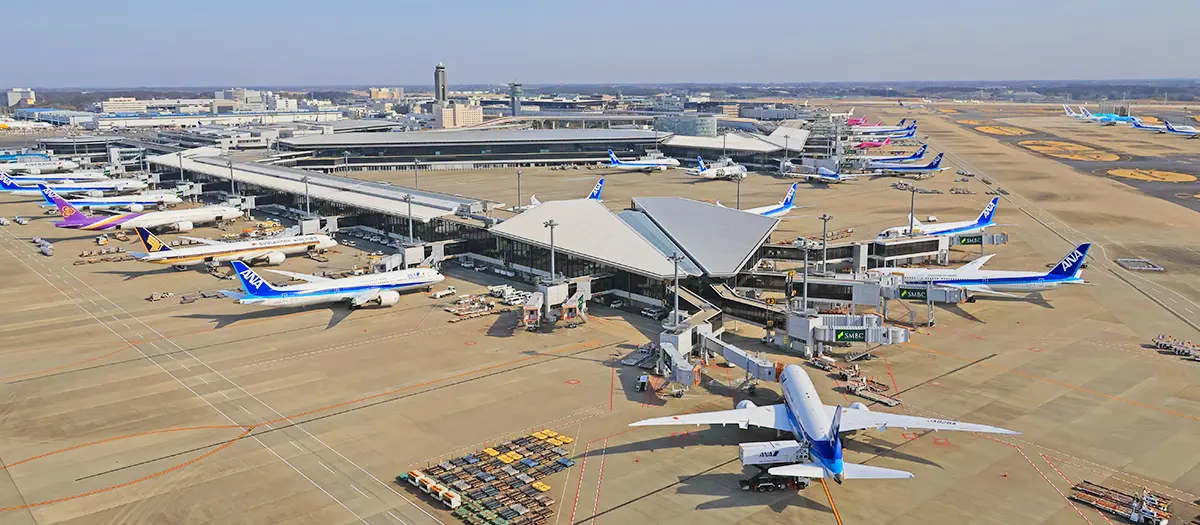
- Share this page
Share this page
- EN
Select Language
- FAVORITES
- Search
Detailed search: You can do a detailed search by keyword, genre, time, area and tag.
Main content starts here.
- Visit Tokyo |
- EXPERIENCES |
- Getting Around |
- Tokyo Airport & Cruise Terminal Access: Narita, Haneda, and others |
- Narita International Airport - getting there, terminal info, and more
Updated: September 2, 2025
Narita International Airport - getting there, terminal info, and more
Narita International Airport (Narita Airport), which opened in Narita City, Chiba Prefecture in 1978, is often called the aerial gateway to Japan.
It benefits from excellent transportation to the center of Tokyo.
Getting to and from Narita International Airport
Narita Airport is located approx. 50-60 kilometers from the center of Tokyo. Depending on your choice of transportation, it takes approx. an hour to get to the center of Tokyo. The express lines out of Narita Airport stop at several of Tokyo's major stations, from which you can head to your specific destination.
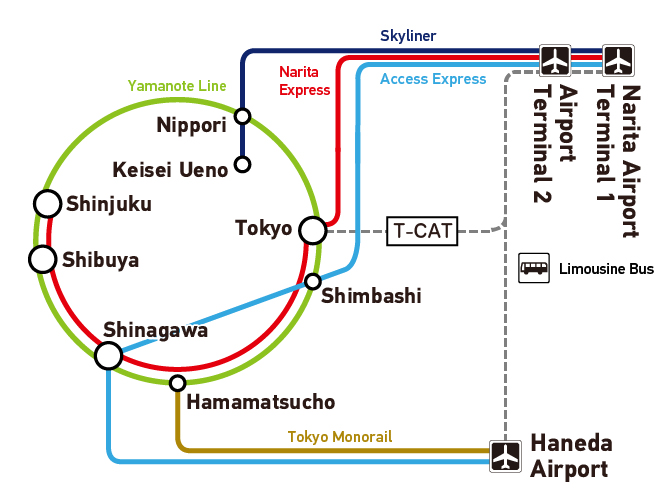
By train
The JR East-operated Narita Express provides a direct link between Narita Airport and major stations, such as Tokyo, Shinagawa, Shibuya, and Shinjuku. Your Japan Rail Pass can be used on this service. The private railway company Keisei also runs the Skyliner from the airport to the Yamanote Line stations of Nippori and Ueno. All seats on those trains must be reserved. You can purchase and/or charge a Suica or PASMO transportation IC card to pay for your journey. Dedicated smartphone apps for mobile IC cards that can be used on automated ticket barriers are also available.
Narita Express
From Narita Airport:
Approx. 60minutes to Tokyo Station
Approx. 90 minutes to Shinjuku Station
Skyliner
From Narita Airport: Approx. 45 minutes to Ueno Station
Access Express
From Narita Airport: Approx. 120 minutes to Haneda Airport
Note: For those who have arrived at Narita in Terminal 2, please get on at Airport Terminal 2 Station, also called Narita Airport Terminal 2-3 Station.
By bus
If you are traveling to a hectic area of Tokyo with lots of baggage, buses are a good option. Highway buses connecting Narita Airport to major stations, hotels, and tourist spots operate frequently.
There are multiple routes into Tokyo. Buses run by different operators may have different stops and terminals. Please be careful to check the bus stops and terminals when purchasing a ticket.
Limousine Bus
From Narita Airport: approx. 60 minutes to Tokyo City Air Terminal
Approx. 85 minutes to Haneda Airport
Note: For more details, check the Limousine Bus timetables.
AIRPORT BUS "TYO-NRT"
From Narita Airport: as fast as 68 minutes to Tokyo Station, and 81 minutes to Ginza Station, for only 1,500 yen per ticket.
Note: Late night and early morning bus rides cost 3,000 yen per ticket. For more information, please check the TYO-NRT timetables.
To/From other domestic cities
Many low-cost carriers operate convenient flights between Narita Airport and major cities across Japan. These routes include multiple flights a day to Kansai International Airport (which serves Osaka, Kyoto and Kobe). It's a 100-minute flight to Osaka, a 100-minute flight to Sapporo in Hokkaido, and a 135-minute flight to Nagasaki.
Narita International Airport to Haneda Airport
Getting from Narita Airport to Haneda Airport generally takes approx. 85 minutes using the limousine bus connection between the two airports, or approx. 120 minutes by Access Express train.
Narita International Airport terminals & map
Narita Airport has three terminals. Many flights serving Narita are international, but domestic flights are also handled, with most being handled at Terminal 3, which was opened in 2015 primarily for low-cost carriers. A free shuttle bus runs between the terminals.
Narita Airport serves three major airline alliances, with Terminal 1 or 2 allocated depending on the alliance to which each airline is affiliated. Generally, SkyTeam uses Terminal 1 North Wing, Star Alliance uses Terminal 1 South Wing, and Oneworld uses Terminal 2.
For more information, check the airport's official website.
You can also see a detailed map here.
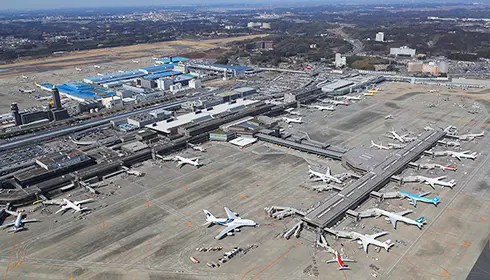
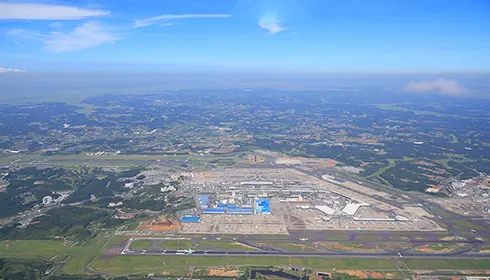
©NARITA INTERNATIONAL AIRPORT CORPORATION
Terminal 1
Terminal 1 is divided into a North Wing and a South Wing (with a central building connecting the two).
The B1 level is where trains arrive and depart (Narita Airport Station), 1F is the arrival lobby (as well as bus & taxi pickup/drop-off), 4F is where you find the departure lobby and various restaurants & shops, and 5F has more restaurants and shops as well as an observation deck.
Terminal 2
Terminal 2 is divided into Main and Satellite Buildings.
The B1 level is where trains arrive and depart (Narita Airport Terminal 2 Station), 1F is the arrival lobby (as well as bus & taxi pickup/drop-off), 3F is where you find the departure lobby, and 4F has restaurants and shops as well as an observation deck.
Terminal 3
Terminal 3 is mainly used by low-cost carriers. It is divided into Main and Satellite Buildings.
1F of the Main Building is the arrival lobby, and 2F of the Main Building is the departure lobby.
Facilities and services
Narita Airport has all sorts of services to help make your airport experience a pleasant one, and your Tokyo experience go more smoothly, from currency exchange and pocket Wi-Fi rental to car rental services.
Wi-Fi router rental and SIM card sales
Pocket Wi-Fi rental and prepaid SIM cards are available from sales counters at Narita Airport, and can also be bought from vending machines.
If you think you do want to use a pocket Wi-Fi during your stay in Tokyo, it might be a good idea to reserve one in advance.
Luggage delivery & storage
Each terminal has a counter handling luggage delivery services. Coin lockers, which can be used for up to eight days, are also available at Terminals 1 and 2.
Other luggage-related services are available, including a clothing storage/"coat check" service and a check-in luggage wrapping service.
Currency exchange・ATMs
All three terminals at Narita Airport have currency exchange kiosks, ATMs and offices selling travel insurance packages.
Car rental
You'll find the counters of several car rental companies in the arrivals area of both Terminal 1 and Terminal 2. If you arrive into Terminal 3 and would like to rent a car, please use the counter at Terminal 2. Kataren – a one-way car rental service – is also available 24 hours a day.
Post office
Both Terminal 1 and Terminal 2 have a post office counter where you can mail letters or small packages either domestically or internationally.
In addition, all three terminals have mailboxes. These are on 1F and 4F in Terminals 1, on 1F and 3F in Terminal 2, and on 2F in Terminal 3.
Things to do at Narita International Airport
Narita Airport has great food, shopping (including lots of duty free), lounges, observation decks, and a capsule hotel.
If you have a longer layover, you could pay a visit to the Naritasan Shinsho-ji Temple, an ancient place of worship that is the city of Narita's main tourist attraction.
Restaurants
There are a wide range of restaurants at Narita Airport, including some that are renowned around Tokyo area.
You have Japanese cuisine such as sushi, soba, and udon, as well as a wide variety of options including ramen, Chinese dishes, and Western-style cuisine.
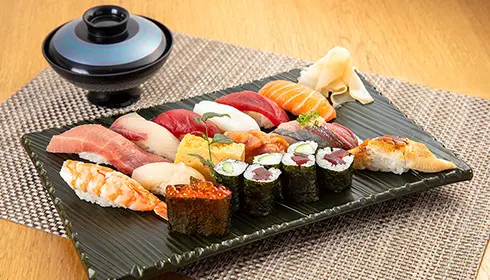

Shopping
Narita Airport has plenty of shops selling a huge selection of souvenirs, and a great selection of fashion brands as well.
Each terminal has a large duty free shop full of luxurious brands.
Lounges
Narita Airport has several lounges run by individual airlines and a few lounges available to people who are members of certain credit cards.
Hotels near Narita airport
Many of the hotels catering to passengers using Narita Airport are on the way from Narita City to the airport, near Keisei Narita Station, or near JR Narita Station. If you're planning on sleeping near the airport the night before an early flight, you're all set, or if you just want a room for a few hours during the day, many hotels will be able to accommodate you.
Capsule hotels and shower rooms inside the airport
Narita is home to a branch of the popular Nine Hours capsule hotel chain. It is located in the B1 level of Terminal 2. It's the perfect place if you're catching an early morning flight, or if you need a nap. You can rent a capsule by the hour, or just rent access to a shower room (up to 1 hour).
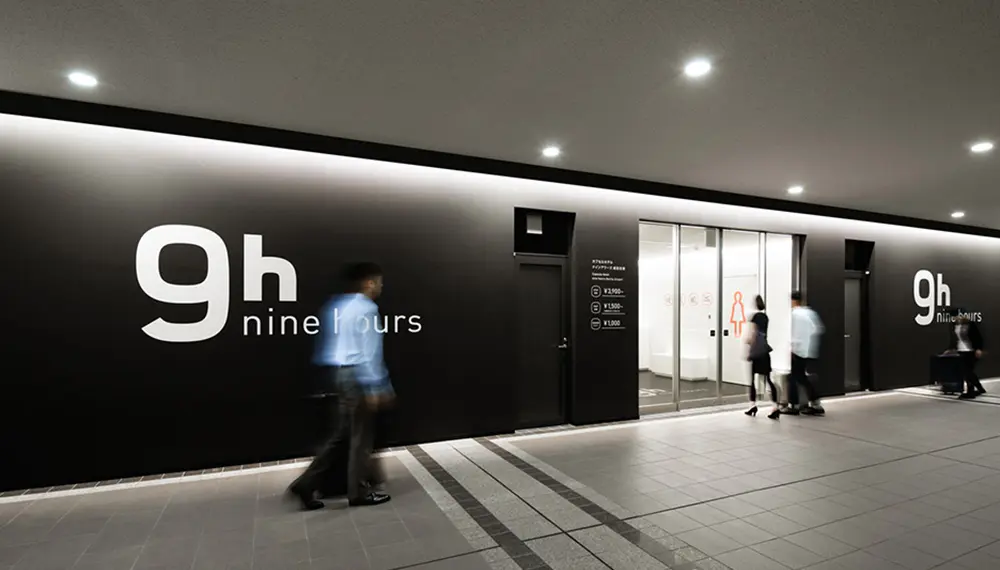
Photo courtesy of Nacasa & Partners
Areas to stay with easy access to the airport
Narita is easily accessible from any area near a stop on the Narita Express (Shinjuku, Shinagawa, Shibuya, Tokyo) or Skyliner (Ueno, Nippori).
Some hotels in central Tokyo offer their own limousine bus services that will take you door-to-door to Narita.